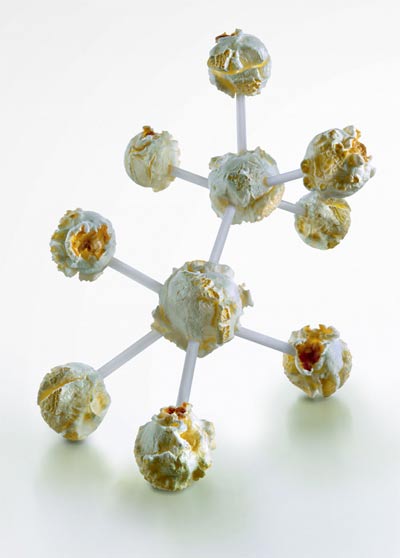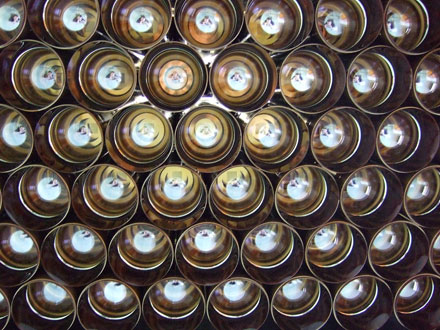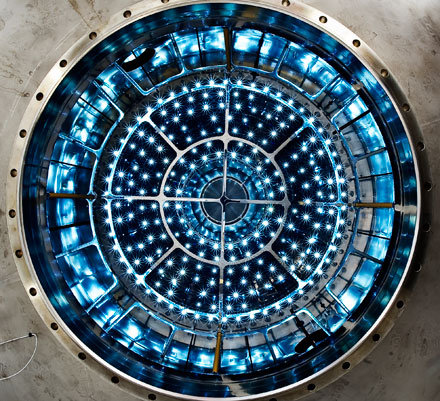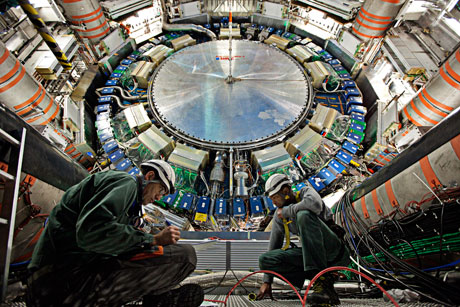29.03.2012: First laureate for Collide@CERN-Geneva Prize announced

The Moebius Strip © Cie Gilles Jobin 2007 (Image: Dorothée Thébert)
The first Collide@CERN-Geneva prize in Dance and Performance was today awarded by jury to the 47-year-old Swiss-born dancer and choreographer Gilles Jobin for his proposal to use interventions and dance to explore the relationship between mind and body at the world's largest particle physics laboratory.
Find out more:
26.03.2012: Third CinéGlobe international film festival at CERN to showcase films inspired by science

CERN will be hosting the CinéGlobe international film festival from 27 March to 1 April. This 3rd edition will see 55 short films "inspired by science" in competition, including fictional pieces as well as documentaries. Selected from a long list of 1,400 short films from 107 countries, all the entrants have one thing in common: telling stories inspired by science and technology. The theme of this year's festival is "Infinitely interconnected", casting the spotlight on how interconnected the modern world has become.
Find out more:
23.03.2012: European Space Agency's Edoardo Amaldi ATV set for liftoff
![[IMAGE]](../features/1203_ESA_ATV.jpg)
Artist's impression of the ESA's first Automated Transfer Vehicle. Image: D. Ducros/ESA
The Italian physicist Edoardo Amaldi was CERN's first Secretary General and a driving force for the creation of the laboratory. He was also one of the founding fathers of the European Space Agency (ESA).
On Friday 23 March ESA's third Automated Transfer Vehicle (ATV), named in honour of Amaldi, began its journey to the International Space Station on board an Ariane rocket.
More information:
- ESA's ATV blog
- ESA press release: ATV-3 set to provide ESA's annual service to Space Station
21.03.2012: CERN's first artist in residence to give public lecture
![[IMAGE]](https://mediastream.cern.ch/MediaArchive/Photo/Public/2012/1203070/1203070_02/1203070_02-A5-at-72-dpi.jpg)
Julius Von Bismarck (right), with his science inspiration partner, James Well.
Creative collisions between the arts and science are just beginning at CERN, with the first Collide@CERN artist, Julius Von Bismarck, starting his digital arts residency this month.
To mark this special occasion, the first Collide@CERN public lecture will take place on 21 March 2012 at the Globe of Science and Innovation, at 7.30 p.m. CET.
Follow the event live: http://webcast.cern.ch
More information:
- Arts@CERN
- Want to attend the event? See the invitation
19.03.2012: LHC reaches new threshold of 4 TeV per beam
![[IMAGE]](https://mediastream.cern.ch/MediaArchive/Photo/Public/2009/0912218/0912218_09/0912218_09-A5-at-72-dpi.jpg)
Physicists in the ATLAS experiment's control room
The Large Hadron Collider reached a new energy threshold of 4 teraelectronvolts (TeV) per beam over the weekend in tests. Increasing the energy at which particles in the LHC collide allows physicists to probe new areas of physics. Collisions at this new energy level are planned for early April.
The LHC is scheduled to run at 4 TeV per beam until late 2012 before going into a long shutdown to prepare for higher energy running. Prior to this the maximum beam energy in the LHC was 3.5 TeV.
More information:
09.03.2012: A major contract has been signed for the supply of solar panels derived from CERN technology

SRB solar field in Valencia, Spain. (Image:CERN)
At Geneva International Airport today SRB Energy delivered the first of the solar panels that will form one of the largest solar energy systems of Switzerland. Ultimately, some 300 high-temperature solar thermal panels will cover a surface of 1200 square metres on the roof of the airport’s main terminal building. The panels, which will be used to keep the buildings warm during the winter and cool in the summer, are derived from vacuum technology developed at CERN for particle accelerators.
Find out more:
Video:
- CERN News
- Geneva airport explains panel construction (in French)
- Interview Cristoforo Benvenuti
- Interview Francisco Segura and shots of solar panels at CERN
Photos:
07.03.2012: CERN experiment makes spectroscopic measurement of antihydrogen

Electrodes for the ALPHA Penning trap are inserted into the vacuum chamber and cryostat assembly. Positrons and antiprotons combine in the trap to form antihydrogen (Image: Niels Madsen ALPHA/Swansea)
In a paper published online today by the journal Nature, the ALPHA collaboration at CERN reports an important milestone on the way to measuring the properties of antimatter atoms. This follows news reported in June last year that the collaboration had routinely trapped antihydrogen atoms for long periods of time. ALPHA’s latest advance is the next important milestone on the way to being able to make precision comparisons between atoms of ordinary matter and atoms of antimatter, thereby helping to unravel one of the deepest mysteries in particle physics and perhaps understanding why a Universe of matter exists at all.
Find out more:
Video:
Photos:
05.03.2012: LHCb experiment squeezes the space for expected new physics

Photomultiplier tubes in the upper box of the LHCb experiment's RICH 1 detector. Image: R. Plackett/CERN for the benefit of the LHCb collaboration
Results presented by the LHCb collaboration this evening at the annual ‘Rencontres de Moriond’ conference, held this year in La Thuile, Italy, have put one of the most stringent limits to date on the current theory of particle physics, the Standard Model. LHCb tests the Standard Model by measuring extremely rare processes, in this case a decay pattern predicted to happen just three times out of every billion decays of a particle known as the Bs (B-sub-s) meson. Anything other than that would be evidence for new physics. Measuring the rate of this Bs decay has been a major goal of particle physics experiments in the past decade, with the limit on its decay rate being gradually improved by the CDF and D0 experiments at Fermilab, LHCb, and most recently CMS at CERN.
Find out more:
- About LHCb
- LHCb website
- CERN Bulletin: New physics further constrained by LHCb results
- Quantum diaries: LHCb finds a few very special events out of 10 billion
- CERN press release
21.02.2012: The non-LHC experiments in 2012

View inside the chamber used by CLOUD, one of the many non-LHC experiments at CERN. Image: CERN
There is more to CERN than the Large Hadron Collider (LHC). A thousand or so physicists on site research topics from antimatter to astronomy in the non-LHC experiments.
This year the ALPHA, ASACUSA, and ATRAP experiments will compare the properties of antiatoms with their matter counterparts, and AEgIS will try to measure the gravitational constant g using antihydrogen. The CLOUD experiment seeks to understand the influence of cosmic rays on cloud formation, while ACE is researching the use of antiproton beams in cancer therapy.
ISOLDE continues to produce radioisotopes for over 50 experiments, and the nTOF facility provides neutron beams for research fields from astronomy to radioactivity. The CAST and OSQAR experiments are hot on the tail of "axions" and "chameleons", some of the many hypothetical and exotic particles proposed by theorists to explain the nature of dark matter.
These are just a few of the many non-LHC experiments looking forward to a productive 2012 at CERN.
Find out more:
- Non-LHC experiments
- Quantum diaries: The hidden face of CERN
15.02.2012: LHC to run at 4 TeV per beam in 2012
© 2012 CERNThe LHC will run with a beam energy of 4 TeV this year, 0.5 TeV higher than in 2010 and 2011. This decision was taken by CERN management following the annual performance workshop held in Chamonix last week and a report delivered today by the external CERN Machine Advisory Committee (CMAC). It is accompanied by a strategy to optimise LHC running to deliver the maximum possible amount of data in 2012 before the LHC goes into a long shutdown to prepare for higher energy running. The data target for 2012 is 15 inverse femtobarns for ATLAS and CMS, three times higher than in 2011. Bunch spacing in the LHC will remain at 50 nanoseconds.
more information:
02.02.2012: What to expect from the LHC in 2012

Engineers at work on the ATLAS calorimeter during last year's maintenance shutdown. Image: CERN
The Large Hadron Collider (LHC), the world's largest particle accelerator, is currently shut down for annual maintenance. In February CERN will decide whether to run the LHC at a total energy of 8 TeV this year, instead of 7 TeV as in 2011. Higher energy should increase the chances of finding heavy particles. By early March, all the magnets around the 27-kilometre accelerator will have been cooled down to their operating temperatures of -271.3°C, ready to guide beams of particles through the LHC.
The LHC will resume colliding protons in late March. The goal is to deliver about 1500 trillion proton-proton collisions (15 inverse femtobarns of data) to the experiments, compared to the 500 trillion collisions delivered in 2011. More collisions will help the LHC experiments to improve the precision of their measurements and push searches for new physics further.
The CMS and ATLAS experiments will continue to look for new particles this year, of which the Higgs boson is the most publicized. Data taken in 2012 will allow them either to confirm a Higgs discovery or to rule out its existence conclusively.
The LHCb experiment will carry on with its precise measurements of quarks, in the search for weak points in the current Standard Model of particle physics. Meanwhile, ALICE is analyzing lead-ion collision data taken in November 2011 in the quest to understand how quark-gluon plasma formed after the Big Bang. More heavy-ion collisions are scheduled for November this year.
Stay tuned for more from CERN in 2012!
More information:
- Quantum diaries: 2012 – The year of the dragon
- Quantum diaries: It might look like a Higgs but does it really sing like one
- ATLAS
- CMS
- LHCb
- ALICE
31.01.2011: Last chance to register for Swiss FameLab semi-finals at CERN
Are you 18 to 35 years old and studying or working in science in Switzerland? Are you passionate about your job and keen on exciting public imagination with a vision of 21st-century science? Then this competition is for you!
FameLab is an international science communication competition for young researchers. It aims to find the new voices of science and engineering across the world.
The regional semi-finals for Switzerland will take place this Saturday 4 February at CERN. To compete, all you have to do is prepare a 3-minute talk that is both engaging and scientifically accurate and aimed at a non-scientific audience. So far, 23 researchers have signed up to present topics ranging from neurobiology to the speed of light.
Registration closes today so be quick! Impress your jury and your audience this Saturday at the Globe of Science and Innovation for your chance to win.
For more information:
- Bulletin article: Enter FameLab and become the new face of FameLab in Switzerland
- Swiss FameLab website
- International FameLab website
- Questions? Write to: info@famelab.ch
16.01.2012: LHC physics – More than just the Higgs search
![[IMAGE]](../features/120116_ATLAS.jpg)
Events containing a muon pair and a photon detected by the ATLAS calorimeter. The three peaks are events consistent with different quarkonium decay states. The scale on the horizontal axis is mass. (Credit: ATLAS)
The LHC has been in the limelight recently with the first tantalizing hints concerning the Higgs boson. But there's more to physics at the LHC. Two of the LHC experiments have recently made discoveries in other areas of particle physics.
In November the LHCb experiment reported a new effect in the decays of particles containing a charm quark (or antiquark). The result could be the first evidence for CP violation - a tiny difference in the behaviour of matter and antimatter - in charmed particles. The effect is very small, but more data should reveal whether it points to physics beyond the Standard Model.
In December the ATLAS experiment announced the discovery of a new "quarkonium state", containing a beauty quark bound with its antiquark. Predicted by theory, it is known as the χb(3P). The new state will help in understanding the force that binds quarks (and antiquarks) together.
Watch out for more discoveries in 2012!
find out more
12.01.2012: Google launches 2012 science fair
In partnership with CERN, the Google science fair 2012 launches today. Now in its second year, the fair is the world's largest global online science competition for young scientists.
Young people in three age categories (13-14, 15-16, and 17-18) are encouraged to post science projects online for the chance to present them before a panel of acclaimed scientists at Google headquarters, and to win prizes including generous scholarships.
Last year's winning projects included investigations into drug-resistance in cancer cells, carcinogenic compounds in grilled chicken, and effects of environmental pollution on asthma.
For more information about this year's fair, take a look at the video above or check out www.google.com/sciencefair.
Everyone has a question. What's yours?